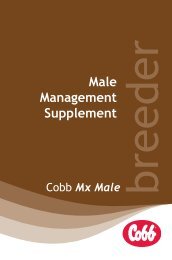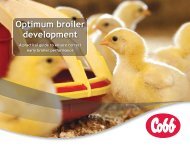Optimum broiler development
1R6eGLk
1R6eGLk
You also want an ePaper? Increase the reach of your titles
YUMPU automatically turns print PDFs into web optimized ePapers that Google loves.
1. Hatchery<br />
1.3. What to measure? – Embryo temperatures<br />
●<br />
Effect of incubation temperature on<br />
hatchability and chick quality can be<br />
seen in the graphs below.<br />
Effect of incubation temperature on hatchability<br />
91.0<br />
Hatch %<br />
Cull %<br />
89.0<br />
87.0<br />
85.0<br />
36.94°C<br />
(98.5°F)<br />
37.78°C<br />
(100.0°F)<br />
Incubation Temperature<br />
38.89°C<br />
(102.0°F)<br />
Effect of incubation temperature on cull rates<br />
2.5<br />
2.0<br />
1.5<br />
1.0<br />
0.5<br />
0<br />
36.94°C 37.78°C 38.89°C<br />
(98.5°F) (100.0°F) (102.0°F)<br />
Incubation Temperature<br />
Factors affecting uniformity of incubation temperatures:<br />
a. Incorrect ventilation – air volume supply, pressures,<br />
damper settings, exhaust ventilation, etc.<br />
b. Temperature calibrations<br />
c. Cooling problems – water flow rates, valves stuck open,<br />
water temperature (too hold/cold), scale in pipes, etc.<br />
d. Over/under utilisation of setting capacities<br />
e. Physics of air movement/design by manufacturer<br />
f. Incorrect setting patterns<br />
g. Maintenance –<br />
poor door seals<br />
h. Maintenance -<br />
correct turning<br />
angle





